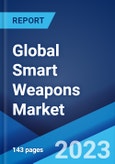The global smart weapons market size reached US$ 17.1 Billion in 2022. Looking forward, the market is expected to reach US$ 24.1 Billion by 2028, exhibiting a growth rate (CAGR) of 5.89% during 2022-2028.
Smart weapons are computer-guided munitions that can hit a target with high accuracy using bullets, land mines, and onboard computers. They are equipped with technologies like laser, television, satellite guidance system, artificial intelligence (AI), and machine learning (ML). These advanced technologies aid military personnel in dealing with combatants on the battlefield and eliminating or reducing the collateral damage. Smart weapons can be programmed to filter unwanted signals in multiple-signal environments and find a specific target on a battlefield.
Smart weapons are computer-guided munitions that can hit a target with high accuracy using bullets, land mines, and onboard computers. They are equipped with technologies like laser, television, satellite guidance system, artificial intelligence (AI), and machine learning (ML). These advanced technologies aid military personnel in dealing with combatants on the battlefield and eliminating or reducing the collateral damage. Smart weapons can be programmed to filter unwanted signals in multiple-signal environments and find a specific target on a battlefield.
Smart Weapons Market Trends
Due to rising geopolitical tensions between countries, military organizations in different parts of the world are focusing on upgrading the existing firefighting equipment of the armed forces. This represents one of the significant factors catalyzing the need for digital innovation and transformation of weapons. Smart weapons assist in analyzing battlefield situations on land, at sea, and in the air. Moreover, advanced technologies can be embedded in electronic warfare (EW) systems to provide augmented reality (AR) information to operators. In line with this, defense research and development (R&D) organizations are developing fully automated smart weapons that can make decisions on strike or self-respond. For instance, the Defense Advanced Research Projects Agency (DARPA), an agency of the United States Department of Defense, funded six organizations to support the Next-Generation Nonsurgical Neurotechnology (N3) program. This program aims at developing high-resolution, bidirectional brain-machine interfaces that can enable diverse national security applications. These applications include controlling active cyber defense systems, multitasking during complex missions, and swarms of unmanned aerial vehicles (UAVs). In addition, the increasing spending on the modernization of the defense sector is driving the market for smart weapons across the globe.Key Market Segmentation
This research provides an analysis of the key trends in each sub-segment of the global smart weapons market report, along with forecasts at the global, regional and country level from 2023-2028. The report has categorized the market based on type, technology and platform.Breakup by Type:
- Missiles
- Anti-Tank Missiles and Standoff Missiles
- Air-to-Air and Air-to-Surface Missiles
- Anti-Ship and Anti-Submarine Missiles
- Munitions
- Guided Bombs
- Target Pods
- Guided Projectiles
- Artillery Shells
- Mortar Rounds
- Guided Rockets
- Anti-Tank and Tactical Rockets
- Air-to-Air and Air-to-Surface
- Anti-Submarine
- Precision Guided Firearms
- Small Smart Weapons
- Shoulder Fired Weapons
- Smart Guns
Breakup by Technology:
- Satellite Guidance
- Radar Guidance
- Infrared Guidance
- Laser Guidance
Breakup by Platform:
- Land-based
- Sea/Naval
- Air
Breakup by Region:
- North America
- United States
- Canada
- Asia-Pacific
- China
- Japan
- India
- South Korea
- Australia
- Indonesia
- Europe
- Germany
- France
- United Kingdom
- Italy
- Spain
- Russia
- Latin America
- Brazil
- Mexico
- Middle East and Africa
Competitive Landscape
The competitive landscape of the industry has also been examined along with the profiles of the key players being Airbus SE, BAE Systems, General Dynamics Corporation, Israel Aerospace Industries, L3Harris Technologies Inc., Lockheed Martin Corporation, Northrop Grumman Corporation, Rafael Advanced Defense Systems Ltd., Raytheon Technologies Corporation, Thales Group and The Boeing Company.Key Questions Answered in This Report:
- How has the global smart weapons market performed so far and how will it perform in the coming years?
- What has been the impact of COVID-19 on the global smart weapons market?
- What are the key regional markets?
- What is the breakup of the market based on the type?
- What is the breakup of the market based on the technology?
- What is the breakup of the market based on the platform?
- What are the various stages in the value chain of the industry?
- What are the key driving factors and challenges in the industry?
- What is the structure of the global smart weapons market and who are the key players?
- What is the degree of competition in the industry?
Table of Contents
1 Preface3 Executive Summary11 Value Chain Analysis13 Price Analysis
2 Scope and Methodology
4 Introduction
5 Global Smart Weapons Market
6 Market Breakup by Type
7 Market Breakup by Technology
8 Market Breakup by Platform
9 Market Breakup by Region
10 SWOT Analysis
12 Porters Five Forces Analysis
14 Competitive Landscape
Companies Mentioned
- Airbus SE
- BAE Systems
- General Dynamics Corporation
- Israel Aerospace Industries
- L3Harris Technologies Inc.
- Lockheed Martin Corporation
- Northrop Grumman Corporation
- Rafael Advanced Defense Systems Ltd.
- Raytheon Technologies Corporation
- Thales Group
- The Boeing Company
Methodology

LOADING...
Table Information
| Report Attribute | Details |
|---|---|
| No. of Pages | 143 |
| Published | November 2023 |
| Forecast Period | 2022 - 2028 |
| Estimated Market Value ( USD | $ 17.1 Billion |
| Forecasted Market Value ( USD | $ 24.1 Billion |
| Compound Annual Growth Rate | 5.9% |
| Regions Covered | Global |
| No. of Companies Mentioned | 11 |









